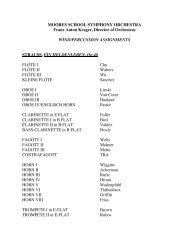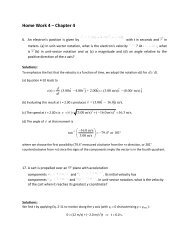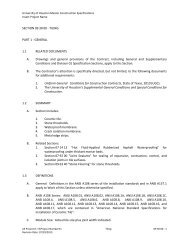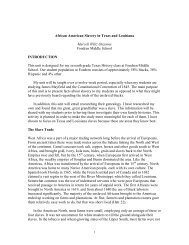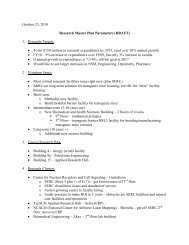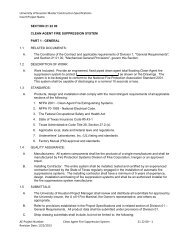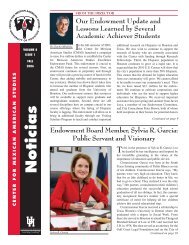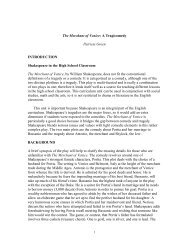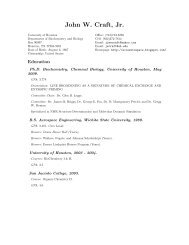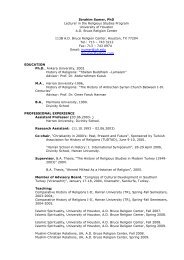Going Green: Biomimicry Francisca Eunice Gomez Rebullida ...
Going Green: Biomimicry Francisca Eunice Gomez Rebullida ...
Going Green: Biomimicry Francisca Eunice Gomez Rebullida ...
Create successful ePaper yourself
Turn your PDF publications into a flip-book with our unique Google optimized e-Paper software.
the Sun is the major source of energy for the plants. Photosynthesis is nature’s system of<br />
allowing producers to grow their food so that animals and humans will have something to eat.<br />
Author: Rachel Carson<br />
Another environmentalist, Rachel Carson, was a marine biologist and a nature writer. Her<br />
career as a writer started when she worked for the US Department of Fisheries. Carson wrote<br />
three books, namely The Sea around Us, The Edge of the Sea, and Under the Sea. These books<br />
were bestsellers because Carson wrote about ocean life, from the shores to the deep waters. In<br />
the 1950s Rachel Carson became involved with environmental research. She was concerned<br />
about pesticides and their effect on humans and animals. In her research Carson found evidence<br />
of the pesticide cancer connection. In addition she did research on many individuals’ illnesses<br />
due to the use of the pesticide. For this reason, Carson wrote another bestseller, Silent Spring, in<br />
1962. It was a very powerful book. The title suggested her concern for the deteriorating natural<br />
world and the negative effects of pesticides on humans and animals. The level of environmental<br />
consciousness of pesticides greatly increased. Carson explains that the pesticides have a<br />
detrimental effect on the environment. This book was one of the reasons that DDT was banned in<br />
the United States. In spite of her bouts with cancer, Carson continued her vocal admonishments<br />
that in the future the use of pesticides would not simply target the pests but weaken the<br />
ecosystem. She maintained that the targeted pests would not be eradicated. Carson appeared in<br />
public to explain her environmental concerns. Finally in April 1964 she passed after fighting<br />
with breast cancer for her life. She bequeathed her writings, papers, and manuscript to Yale<br />
University and has inspired many people to nurture and protect our natural environment. One of<br />
them is Janine Benyus.<br />
Plants<br />
Plants come in all different shapes and sizes, but they all have the same parts – namely,<br />
roots, leaves, and stems. Plants can also have flowers, seeds, and fruits or nuts. Plants are<br />
important to all people and animals because we need food to stay alive. Plants are producers<br />
because they can make their own food through the process of photosynthesis. People and animals<br />
are the consumers. They need to get energy from the plants. Plants are important to humans<br />
because they provide aesthetic value, medicine, food, goods, recreation, air quality, water control,<br />
and erosion control, as well as having an impact on our climate, fish and wildlife habitats, and the<br />
ecosystem. Plants make our surroundings beautiful. Imagine the beautiful bluebonnets, flowers<br />
native to Texas that grow abundantly during spring. We see them growing wild on the sides of<br />
the streets, parks, and vacant land. They need to be exposed to the Sun directly for eight to ten<br />
hours to thrive well. These beautiful blue bonnets are the pride of Texas.<br />
Medicinal plants such as chinaberry or china tree, cypress, juniper, live oak, mistletoe, Osage,<br />
pecan, vitex, and yaupon are native to Texas. The chinaberries have yellow flowers and yellow<br />
poisonous fruit. Their toxicity depends on tree varieties. Native Americans used the plant<br />
externally to treat ringworms and tetterworms. The Cherokees used the leaves to repel insects<br />
from shelters and homes. The chinaberry fruit was dried and made into ceremonial beads. Native<br />
Americans believed that the fruits brought them good fortune. The bark was used as poison to<br />
fish. When eaten, the fish were stunned and easily captured (“Chinaberry”).<br />
The bald cypress trees are also found in Texas. Their bark is used to make cordage. Native<br />
Americans also used the bark as fire starters. The bald cypress trees grow in wetlands and are<br />
known as disease free trees. Florida cranes eat the seeds of the bald cypress. Other animals like<br />
deer and rabbits eat the young sapling. The bark is eaten by nutria (a large rodent with webbed<br />
feet) and other rodents. The root trees are made into furniture like table tops and house décor<br />
(“Cypress”).<br />
<strong>Francisca</strong> <strong>Eunice</strong> <strong>Gomez</strong> <strong>Rebullida</strong> 73



